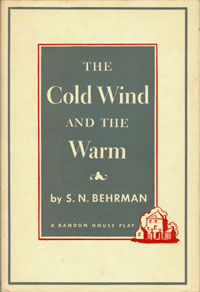|
 |
The
Cold Wind and the Warm
S. N. Behrman
New York:
Random House, 1959
First edition in dust jacket
Inscribed by Behrman |
| |
|
(On front free endpaper)
For Harold, / I would like to get /
you interested in this / play. It is only a / first draft,
you know! / Any suggestions? / With love and / gratitude, /
from / Sam / New York: November, 1959.
Inscribed to director Harold Clurman, the
inscription is clearly facetious; Clurman directed the play
on itís opening at the Morosco Theatre in New York City, on
December 8, 1958, with Eli Wallach in the role of Willie. |
|
|
No play in Behrmanís lifetime offered more
resistance in just getting down on paper than The Cold
Wind and the Warm. Nearly three years passed before the
story developed as in the published version, plus an
additional two years of rewrites before the first script
reached producer Robert Whitehead. All this does not take
into account the extensive rewriting that followed,
including minor changes after the New York premiere. By
contrast, Behrman wrote Biography between 8 April and
9 June of 1932, and it went into fall rehearsal with a
December premiere on Broadway. The Second Man took
only three weeks to write. That the material of The Cold
Wind and the Warm proved so intractable represents an
interesting facet of Behrmanís personality. It is, of
course, regrettable that the always skillful craftsman never
achieved the necessary distancing which would have enabled
him to create a Willie Lavin (Daniel Asher) for the theatre
who is both believable and pathetic. Behrman explained: "If
he was just a character in a play, it would have been simple
to give his act a meaning, but real life is not so
explicable .... He was fine on solving the larger problems
of the world, but not the small personal ones. As I put it
just now, ĎHe couldnít face the everyday responsibilities of
a permanent attachment.í" Consequently in being true to the
mercurial original, Behrman created something of a false
character. The density of personality, the psychological
complexity that could always be counted on as a hallmark in
any of Behrmanís leading characters, is nowhere to be seen
in Willie Lavin. The theatricalized version of Daniel Asher
leaves the spectator largely perplexed, confused, and
dissatisfied. No amount of last-minute tinkering with the
production in Boston (where the voice-over prologue was
rushed in as a device to foretell the inexplicable suicide
that would unfold before the spectator) could salvage this
somewhat flawed characterization. It is bitterly ironic that
Behrmanís attempt to exercise the ghost of Daniel Asher and
to acknowledge his own responsibility for failing his friend
and mentor at a time of great need fell short of the desired
achievement. Instead of his art assisting in a catharsis, it
merely increased his pain through frustration and ultimate
disappointment in the lukewarm reception the play received
on Broadway. The Cold Wind and the Warm contains some
of Behrmanís finest mature writing and remains a huge
favorite among his coterie, indicating that perhaps it may
attain a larger and more appreciative audience in the
future. The structure of the comedy-drama seems to employ
motion picture technique Ė that is, fragments, moments,
scenes that form the fabric of the memory play genre.
Willieís unrequited love for Myra fails to satisfy everyone
as a motivation for Willieís suicide, and this controversy
probably would have remained had Behrmanís screenplay
reached the shooting stage. For the film version, however,
Behrman intensifies the pressure on Willie by having Myra at
last make herself available to Willie just after he has
proposed to and been accepted by Leah. Tobey Sacher,
Behrmanís persona and the pivotal character in The Cold
Wind and the Warm, grows to manhood in the light of the
sun and the moon of his universe, his loving Aunt Ida, and
his intellectual mentor, Willie Lavin. The neighborhood, the
town, surely the whole world basks in the warm glow of Aunt
Idaís outgoing personality, her unselfish, free matchmaking,
her practical, no-nonsense approach to daily existence, and
a fulfilling life. Tobey is no exception. But the mercurial
nature of the questing Willie, who dissects the mysteries of
the universe, greatly influences Tobey during his maturing
years, always providing answers for the youthís curiosity.
At moments Willie proves to be a god with feet of clay, even
to the naive Tobey. Even more awesome than what lies beyond
infinity is why Willie refuses to accept the close-at-hand
Leah for the unreachable Myra, or why he cannot bring order
to his life and devote himself to the pursuit of one
profession. Seven years pass in which, at last, Tobey begins
to establish his reputation as a musician, while Willie
remains a free-floating drifter, still brilliant of mind and
pursuing his own will-oí-the-wisp. Tobey forces his friend
to face the reality of his misspent life. Willie, attempting
to obey the tenets of Tobeyís well-ordered existence, ends
his life. Tobey finds himself obliged to live on without his
friend but never really relieved of the mystery of
motivation nor of his own possible responsibility for
Willieís death. |
|